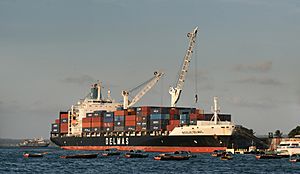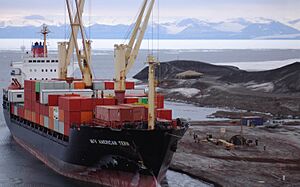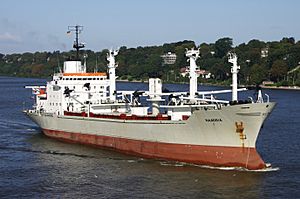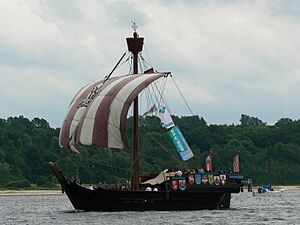Cargo ship facts for kids
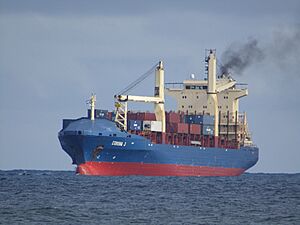
A cargo ship or freighter is a large boat that carries goods and materials from one port to another. Thousands of these ships travel the world's seas and oceans every year. They move most of the goods traded between countries. Cargo ships are built for this job. They often have cranes and other tools to load and unload items. They come in many sizes. Today, most are made of welded steel. They usually last about 25 to 30 years before they are taken apart.
Contents
What Are Cargo Ships?
The words cargo and freight are often used to mean the same thing. But technically, "cargo" means the goods being carried on the ship. "Freight" means the act of carrying those goods. However, people have used these words interchangeably for hundreds of years.
The modern shipping business has two main types:
- Liner business: These are usually container ships. They carry "general cargo" in large containers (20 or 40 feet long). They follow a regular schedule and stop at specific ports. Anyone can book space on these ships to send their goods.
- Tramp-tanker business: This is usually a private agreement between the person sending goods and the person receiving them. Ship owners offer their vessels to carry large amounts of goods (like liquids or loose items) to any suitable port. This is done through a special contract.
Larger cargo ships are often run by shipping lines. These are companies that specialize in moving cargo. Smaller ships, like coasters, are often owned by the people who operate them.
Types of Cargo Ships
Cargo ships can be put into different groups based on what they carry:
- General cargo vessels: These ships carry packaged items. This includes things like chemicals, food, furniture, machines, cars, shoes, and clothes.
- Container ships: These ships carry all their goods in truck-sized intermodal containers. This method is called containerization. They are a very common way to move goods by sea. Most non-bulk cargo (items not in loose form) travels this way. A container ship's size is measured in twenty-foot equivalent units (TEU).
- Tankers: These ships carry petroleum products or other liquids.
- Dry bulk carriers: These ships carry loose items. Examples include coal, grain, and ore.
- Multi-purpose vessels: As the name suggests, these ships can carry different types of cargo at the same time. For example, they might carry both liquids and general cargo.
- Reefer ships: These are also called Refrigerated ships. They are designed to carry goods that need to be kept cold. This includes fruits, meat, fish, vegetables, and dairy products.
- Roll-on/roll-off (RORO or ro-ro) vessels: These ships carry wheeled vehicles. Things like cars, trucks, and even train cars can drive directly on and off the ship.
- Timber (Lumber) carriers: These ships transport lumber, logs, and other wood products.
Some cargo ships follow a fixed schedule and have set prices. These are called cargo liners. Other ships, called tramp ships, do not have fixed schedules. People hire them to carry specific loads. Smaller shipping companies often operate tramp ships.
Ship Sizes
Cargo ships are also grouped by their size. This includes how much cargo they can carry (tonnage), their weight (deadweight tonnage DWT), and their dimensions. The length, width (beam), and how deep they sit in the water (draft) limit which canals or harbors they can use. Their height also matters for passing under bridges.
Common size categories include:
- Dry cargo ships:
- Seawaymax: These are the largest ships that can fit through the St. Lawrence Seaway. They are less than 740 feet (225 meters) long and 78 feet (24 meters) wide.
- Panamax: These are the largest ships that can fit through the original locks of the Panama Canal. They are about 965 feet (294 meters) long and 106 feet (32 meters) wide.
- Neopanamax: These ships can use the newer, larger locks of the Panama Canal. They are about 1,200 feet (366 meters) long and 180 feet (55 meters) wide.
- Capesize: These ships are too big for the Suez or Panama Canals. They must travel around Cape Agulhas (Africa) or Cape Horn (South America) to get between oceans. They are usually around 950 feet (290 meters) long.
- Chinamax: These are very large carriers, up to 1,180 feet (360 meters) long and 213 feet (65 meters) wide. Their size is limited by port facilities in China.
- Wet cargo ships (Tankers):
- Aframax: Oil tankers between 75,000 and 115,000 DWT.
- Suezmax: Ships that can fit through the Suez Canal. They are usually about 160,000 DWT.
- VLCC (Very Large Crude Carrier): Huge supertankers between 150,000 and 320,000 DWT.
- ULCC (Ultra Large Crude Carrier): Enormous supertankers between 320,000 and 550,000 DWT.
The TI-class supertanker is an Ultra Large Crude Carrier. It sits deeper in the water than ships that can use the Suez or Panama Canals. This means it has to take very long routes, like sailing around the southern tips of Africa or South America.
Lake freighters are built for the Great Lakes in North America. They are designed differently from ocean ships because of the different wave sizes on the lakes. Some of these ships are so large they cannot leave the lakes and enter the Atlantic Ocean because they don't fit through the locks on the Saint Lawrence Seaway.
History of Cargo Ships
People have been using boats to carry goods for trade for a very long time. Records show this was common by 1000 BC. As early as the 14th and 15th centuries BC, small Mediterranean cargo ships, like the 50-foot-long (15-16 meter) Uluburun ship, carried 20 tons of valuable goods. This included copper, jars, glass, ivory, gold, and spices from different ancient lands. The desire to trade over longer distances and throughout more of the year led to better ship designs during the Middle Ages.
Before the mid-1800s, piracy was common. So, most cargo ships were armed, sometimes heavily. They were also sometimes protected by warships.
Piracy Today
Piracy still happens in some parts of the world. It is especially common in the Strait of Malacca, a narrow channel between Indonesia and Singapore / Malaysia. Cargo ships are often targeted there. In 2004, the governments of these three nations agreed to better protect ships passing through the Straits. Waters near Somalia and Nigeria also have piracy. Smaller boats are also at risk along parts of the South American and Southeast Asian coasts, and near the Caribbean Sea.
Ship Names and Prefixes
A special code often appears before a ship's name. This code tells you what kind of ship it is. For example, "USS" means United States Ship (for naval ships). For merchant ships, you might see:
- "MV" (Motor Vessel): This means the ship is powered by a diesel engine.
- "MT" (Motor Tanker): This is a motor vessel that carries only liquids.
- "SS" (Screw Steamer): This means the ship is driven by propellers or screws, often understood to mean Steamship.
Famous Cargo Ships
Some cargo ships are very famous. During World War II, 2,710 Liberty ships were built. These ships were based on a British design. Parts of Liberty ships were made in different places across the United States. Then, shipbuilders put them together very quickly, sometimes in just over four days! These ships helped the Allies replace sunken cargo vessels faster than German U-boats could sink them. They played a big part in delivering supplies and winning the war. After the war, many of these ships were sold to private companies.
The Ever Given is a ship that got stuck in the Suez Canal from March 25 to 28, 2021. This caused a big halt in global trade. The MV Dali collided with the Francis Scott Key Bridge in Baltimore, Maryland, United States, on March 26, 2024. This caused a major bridge collapse.
Pollution from Ships
Most large cargo ships use a type of fuel called bunker fuel, also known as heavy fuel oil. This fuel is cheap but contains high levels of sulphur. This causes pollution. The amount of pollution is growing. However, new international rules are being put in place to greatly reduce sulphur in marine fuels and cut down on nitrogen oxide emissions. Some solutions include switching to cleaner fuels like clean diesel or marine gas oil. Also, ships can connect to shore power (called cold ironing) when they are in port. If these rules are followed, the International Maritime Organization's requirements will lead to a 90% drop in sulphur oxide emissions. The European Union is also planning stricter controls.
See also
 In Spanish: Buque de carga para niños
In Spanish: Buque de carga para niños
- Classification of European Inland Waterways
- MARPOL 73/78
- Merchant Navy (United Kingdom)
- Merchant vessel
- Ship transport
- United States Merchant Marine
Images for kids
-
Cargo ship at Puerto Cortés in Honduras.
-
A US cargo ship off McMurdo Station, Antarctica.


